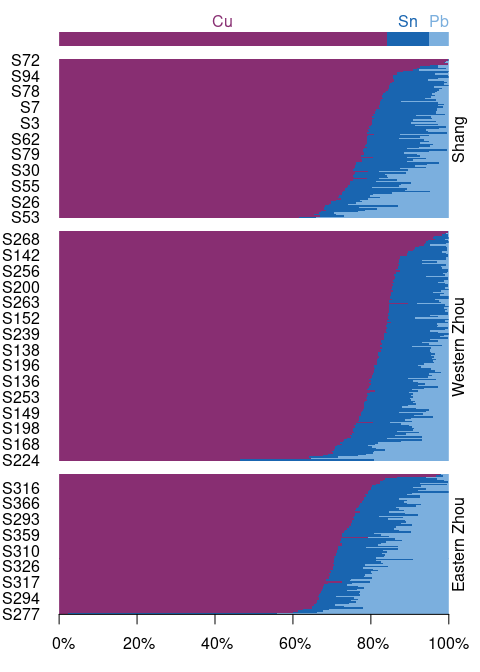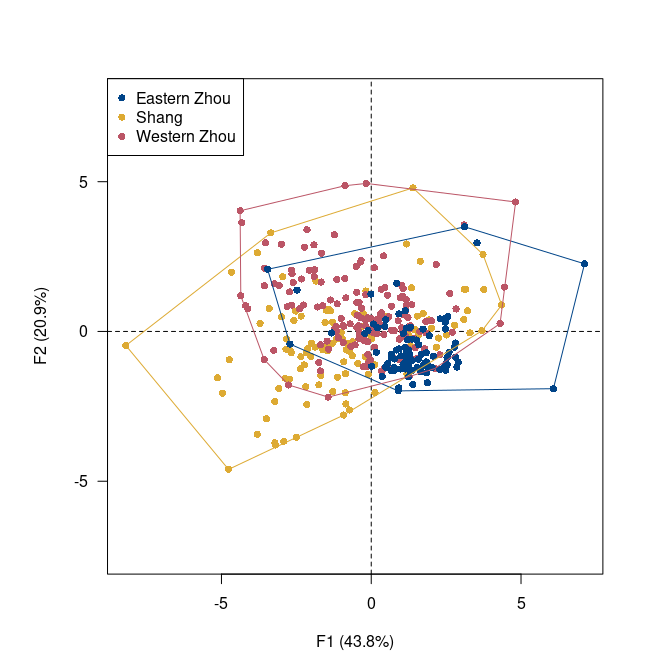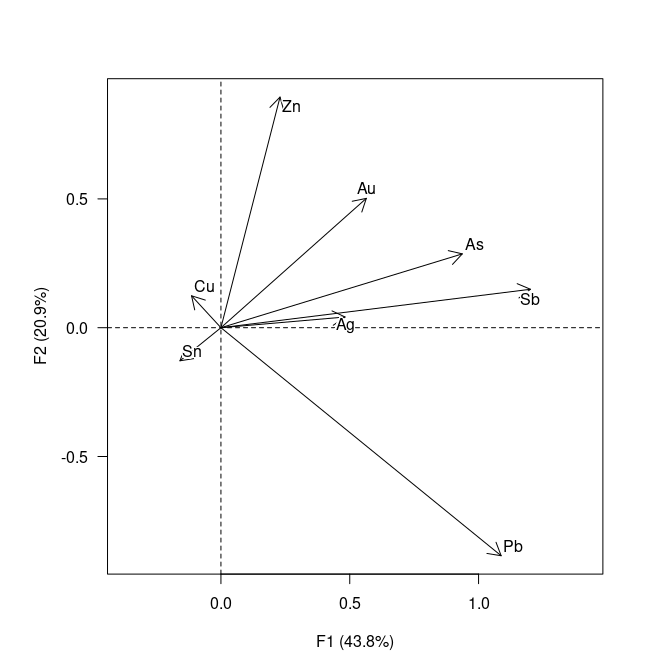Exploration and analysis of compositional data in the framework of J.
Aitchison (1986). nexus provides tools for chemical
fingerprinting and source tracking of ancient materials. This package
provides methods for compositional data analysis:
This package provides translations of user-facing communications,
like messages, warnings and errors, and graphical elements (axis
labels). The preferred language is by default taken from the locale.
This can be overridden by setting of the environment variable
LANGUAGE (you only need to do this once per session):
Aitchison, J. 1986. The Statistical Analysis of Compositional
Data. Monographs on Statistics and Applied Probability. Londres, UK
; New York, USA: Chapman and Hall.
———. 1997. “The One-Hour Course in Compositional Data Analysis or
Compositional Data Analysis Is Simple.” In IAMG’97, edited by
V. Pawlowsky-Glahn, 3–35. Barcelona: International Center for Numerical
Methods in Engineering (CIMNE).
Aitchison, John, and Michael Greenacre. 2002. “Biplots of Compositional
Data.”
Journal of the Royal Statistical Society: Series C (Applied
Statistics) 51 (4): 375–92.
https://doi.org/10.1111/1467-9876.00275.
Baxter, M. J., C. C. Beardah, I. Papageorgiou, M. A. Cau, P. M. Day, and
V. Kilikoglou. 2008. “On Statistical Approaches to the Study of Ceramic
Artefacts Using Geochemical and Petrographic Data.”
Archaeometry 50 (1): 142–57.
https://doi.org/10.1111/j.1475-4754.2007.00359.x.
Beardah, C. C., M. J. Baxter, I. Papageorgiou, and M. A. Cau. 2003.
““Mixed-mode” Approaches to the Grouping of
Ceramic Artefacts Using S-Plus.” In The Digital Heritage of
Archaeology., edited by M. Doerr and A. Sarris, 261–66. Athens:
Archive of Monuments and Publications, Hellenic Ministry of Culture.
Boogaart, K. Gerald van den, and Raimon Tolosana-Delgado. 2013.
Analyzing Compositional Data with R. Use R! Berlin Heidelberg:
Springer-Verlag.
https://doi.org/10.1007/978-3-642-36809-7.
Cau, Miguel-Angel, Peter M Day, Michael J Baxter, Ioulia Papageorgiou,
Ioannis Iliopoulos, and Giuseppe Montana. 2004. “Exploring Automatic
Grouping Procedures in Ceramic Petrology.”
Journal of Archaeological
Science 31 (9): 1325–38.
https://doi.org/10.1016/j.jas.2004.03.006.
Egozcue, J. J., V. Pawlowsky-Glahn, G. Mateu-Figueras, and C.
Barceló-Vidal. 2003. “Isometric Logratio Transformations for
Compositional Data Analysis.”
Mathematical Geology 35 (3):
279–300.
https://doi.org/10.1023/A:1023818214614.
Egozcue, Juan José, Caterina Gozzi, Antonella Buccianti, and Vera
Pawlowsky-Glahn. 2024. “Exploring Geochemical Data Using Compositional
Techniques: A Practical Guide.”
Journal of Geochemical
Exploration 258 (March): 107385.
https://doi.org/10.1016/j.gexplo.2024.107385.
Egozcue, Juan José, and Vera Pawlowsky-Glahn. 2023. “Subcompositional
Coherence and and a Novel Proportionality Index of Parts.”
SORT
47 (2): 229–44.
https://doi.org/10.57645/20.8080.02.7.
Filzmoser, Peter, Robert G. Garrett, and Clemens Reimann. 2005.
“Multivariate Outlier Detection in Exploration Geochemistry.”
Computers & Geosciences 31 (5): 579–87.
https://doi.org/10.1016/j.cageo.2004.11.013.
Filzmoser, Peter, and Karel Hron. 2008. “Outlier Detection for
Compositional Data Using Robust Methods.”
Mathematical
Geosciences 40 (3): 233–48.
https://doi.org/10.1007/s11004-007-9141-5.
Filzmoser, Peter, Karel Hron, and Clemens Reimann. 2009a. “Principal
Component Analysis for Compositional Data with Outliers.”
Environmetrics 20 (6): 621–32.
https://doi.org/10.1002/env.966.
———. 2009b. “Univariate Statistical Analysis of Environmental
(Compositional) Data: Problems and Possibilities.”
Science of The
Total Environment 407 (23): 6100–6108.
https://doi.org/10.1016/j.scitotenv.2009.08.008.
———. 2010. “The Bivariate Statistical Analysis of Environmental
(Compositional) Data.”
Science of The Total Environment 408
(19): 4230–38.
https://doi.org/10.1016/j.scitotenv.2010.05.011.
———. 2012. “Interpretation of Multivariate Outliers for Compositional
Data.”
Computers & Geosciences 39: 77–85.
https://doi.org/10.1016/j.cageo.2011.06.014.
Filzmoser, Peter, Karel Hron, and Matthias Templ. 2018.
Applied
Compositional Data Analysis: With Worked Examples in R. Use R!
Berlin Heidelberg: Springer-Verlag.
https://doi.org/10.1007/978-3-319-96422-5.
Fišerová, Eva, and Karel Hron. 2011. “On the Interpretation of
Orthonormal Coordinates for Compositional Data.”
Mathematical
Geosciences 43 (4): 455–68.
https://doi.org/10.1007/s11004-011-9333-x.
Greenacre, Michael. 2021. “Compositional Data Analysis.”
Annual
Review of Statistics and Its Application 8 (1): 271–99.
https://doi.org/10.1146/annurev-statistics-042720-124436.
Greenacre, Michael J. 2019. Compositional Data Analysis in
Practice. Chapman & Hall/CRC Interdisciplinary Statistics. Boca
Raton: CRC Press, Taylor & Francis Group.
Greenacre, Michael, and Jonathan R. Wood. 2024. “A Comprehensive
Workflow for Compositional Data Analysis in Archaeometry, with Code in
R.”
Archaeological and Anthropological Sciences 16 (10): 171.
https://doi.org/10.1007/s12520-024-02070-w.
Grunsky, Eric, Michael Greenacre, and Bruce Kjarsgaard. 2024. “GeoCoDA:
Recognizing and Validating Structural Processes in Geochemical Data. A
Workflow on Compositional Data Analysis in Lithogeochemistry.”
Applied Computing and Geosciences 22 (June): 100149.
https://doi.org/10.1016/j.acags.2023.100149.
Hron, Karel, Peter Filzmoser, Patrice de Caritat, Eva Fišerová, and
Alžběta Gardlo. 2017. “Weighted Pivot Coordinates for Compositional Data
and Their Application to Geochemical Mapping.”
Mathematical
Geosciences 49 (6): 797–814.
https://doi.org/10.1007/s11004-017-9684-z.
Hron, Karel, and Lubomír Kubáček. 2011. “Statistical Properties of the
Total Variation Estimator for Compositional Data.”
Metrika 74
(2): 221–30.
https://doi.org/10.1007/s00184-010-0299-3.
Hron, K., M. Templ, and P. Filzmoser. 2010. “Imputation of Missing
Values for Compositional Data Using Classical and Robust Methods.”
Computational Statistics & Data Analysis 54 (12):
3095–3107.
https://doi.org/10.1016/j.csda.2009.11.023.
Martín-Fernández, J. A., C. Barceló-Vidal, and V. Pawlowsky-Glahn. 2003.
“Dealing with Zeros and Missing Values in Compositional Data Sets Using
Nonparametric Imputation.”
Mathematical Geology 35 (3): 253–78.
https://doi.org/10.1023/A:1023866030544.
Pawlowsky-Glahn, V., and J. J. Egozcue. 2001. “Geometric Approach to
Statistical Analysis on the Simplex.”
Stochastic Environmental
Research and Risk Assessment 15 (5): 384–98.
https://doi.org/10.1007/s004770100077.
Rousseeuw, Peter J., and Bert C. van Zomeren. 1990. “Unmasking
Multivariate Outliers and Leverage Points.”
Journal of the American
Statistical Association 85 (411): 633–39.
https://doi.org/10.1080/01621459.1990.10474920.
Santos, Frédéric. 2020. “Modern Methods for Old Data: An Overview of
Some Robust Methods for Outliers Detection with Applications in
Osteology.”
Journal of Archaeological Science: Reports 32:
102423.
https://doi.org/10.1016/j.jasrep.2020.102423.
Weigand, P. C., G. Harbottle, and E. Sayre. 1977. “Turquoise Sources and
Source Analysisis: Mesoamerica and the Southwestern U.S.A.” In
Exchange Systems in Prehistory, edited by J. Ericson and T. K.
Earle, 15–34. New York, NY: Academic Press.




